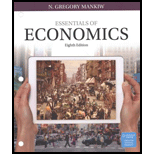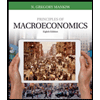
The impact of a binding
Answer to Problem 1CQQ
Option ‘d’ is correct.
Explanation of Solution
The
Option (d):
When there is a price floor in the economy, then the producers will get a minimum of the floor price and this will increase the revenue of the producers. This minimum guaranteed price would lead to the increased supply by the producers; more than the economic
Option (a):
When there is a price floor in the economy, then the producers will get a minimum of the floor price and this will increase the revenue of the producers. This minimum guaranteed price would lead to the increased supply by the producers; more than the economic demand in the economy. This causes the movement up along the existing supply curve and there will be no shift in the supply curve. Thus, option ‘a’ is incorrect.
Option (b):
When there is a price floor in the economy, then the producers will get a minimum of the floor price and this will increase the revenue of the producers. This minimum guaranteed price would lead to the increased supply by the producers; more than the economic demand in the economy. Since the price is set by the government, the demand will remain the same and usually, the floor price will be set above the
Option (c):
When there is a price floor in the economy, then the producers will get a minimum of the floor price and this will increase the revenue of the producers. This minimum guaranteed price would lead to the increased supply by the producers; more than the economic demand in the economy. This increased supply causes the economic surplus in the economy and not economic shortage. Thus, option ‘c’ is incorrect.
Concept introduction:
Price floor: It is the minimum legal price set for a commodity or service by the government or the authority. This is to prevent the prices from going too low.
Want to see more full solutions like this?
Chapter 6 Solutions
Bundle: Essentials Of Economics, Loose-leaf Version, 8th + Lms Integrated Mindtap Economics, 1 Term (6 Months) Printed Access Card
- how commond economies relate to principle Of Economics ?arrow_forwardCritically analyse the five (5) characteristics of Ubuntu and provide examples of how they apply to the National Health Insurance (NHI) in South Africa.arrow_forwardCritically analyse the five (5) characteristics of Ubuntu and provide examples of how they apply to the National Health Insurance (NHI) in South Africa.arrow_forward
- Outline the nine (9) consumer rights as specified in the Consumer Rights Act in South Africa.arrow_forwardIn what ways could you show the attractiveness of Philippines in the form of videos/campaigns to foreign investors? Cite 10 examples.arrow_forwardExplain the following terms and provide an example for each term: • Corruption • Fraud • Briberyarrow_forward
- In what ways could you show the attractiveness of a country in the form of videos/campaigns?arrow_forwardWith the VBS scenario in mind, debate with your own words the view that stakeholders are the primary reason why business ethics must be implemented.arrow_forwardThe unethical decisions taken by the VBS management affected the lives of many of their clients who trusted their business and services You are appointed as an ethics officer at Tyme Bank. Advise the management regarding the role of legislation in South Africa in providing the legal framework for business operations.arrow_forward
 Managerial Economics: A Problem Solving ApproachEconomicsISBN:9781337106665Author:Luke M. Froeb, Brian T. McCann, Michael R. Ward, Mike ShorPublisher:Cengage Learning
Managerial Economics: A Problem Solving ApproachEconomicsISBN:9781337106665Author:Luke M. Froeb, Brian T. McCann, Michael R. Ward, Mike ShorPublisher:Cengage Learning Principles of Macroeconomics (MindTap Course List)EconomicsISBN:9781305971509Author:N. Gregory MankiwPublisher:Cengage Learning
Principles of Macroeconomics (MindTap Course List)EconomicsISBN:9781305971509Author:N. Gregory MankiwPublisher:Cengage Learning Exploring EconomicsEconomicsISBN:9781544336329Author:Robert L. SextonPublisher:SAGE Publications, Inc
Exploring EconomicsEconomicsISBN:9781544336329Author:Robert L. SextonPublisher:SAGE Publications, Inc Microeconomics: Private and Public Choice (MindTa...EconomicsISBN:9781305506893Author:James D. Gwartney, Richard L. Stroup, Russell S. Sobel, David A. MacphersonPublisher:Cengage Learning
Microeconomics: Private and Public Choice (MindTa...EconomicsISBN:9781305506893Author:James D. Gwartney, Richard L. Stroup, Russell S. Sobel, David A. MacphersonPublisher:Cengage Learning Economics: Private and Public Choice (MindTap Cou...EconomicsISBN:9781305506725Author:James D. Gwartney, Richard L. Stroup, Russell S. Sobel, David A. MacphersonPublisher:Cengage Learning
Economics: Private and Public Choice (MindTap Cou...EconomicsISBN:9781305506725Author:James D. Gwartney, Richard L. Stroup, Russell S. Sobel, David A. MacphersonPublisher:Cengage Learning





